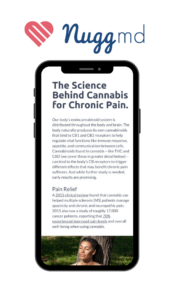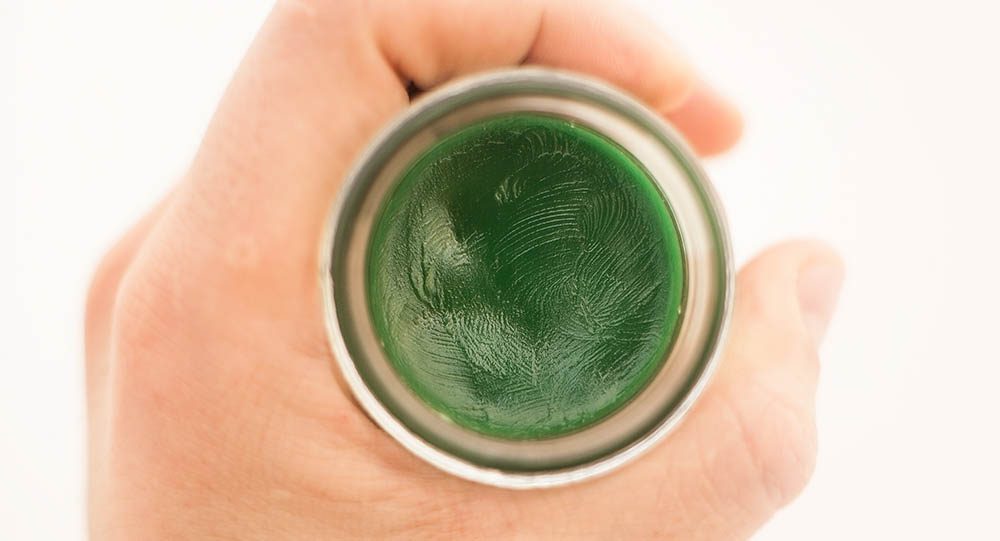In This Article
- What Research Says About Taking Cannabis for Pain Relief
- Understanding CBD and THC for Pain Relief
- How to Take Cannabis to Improve Chronic Pain
- How Much Cannabis Should You Take for Effective Pain Relief?
- How to Get Access to Medical Marijuana for Pain Relief
- Risks and Side Effects of Using Cannabis for Pain
- How does cannabis help chronic pain?
- What cannabinoids are good for pain?
- Do terpenes help with pain?
While additional research is required, growing lab studies and scores of anecdotal reports appear to indicate that using cannabis for pain management may work for scores of people. Be it THC, CBD, a combination of both or other cannabinoids, many say the plant helps with their pains. As such, people living with minor (short-lived, intense) or chronic (ongoing for months or longer) pain may want to consider the healing power of the plant if they haven't just yet.
Using cannabis for chronic pain management is a concept many have warmed to in recent years. The sentiment came as traditional drugs derived from opium and chemically similar compounds led to the deadly addiction pandemic still gripping the globe. Even when effective and non-habit-forming, these opiate-based prescriptions can lead to nausea and extreme sedation.
While opiates do work for some, the effects they've had on society lead many to believe alternatives, possibly cannabis, are better for their unique needs.

Find natural, lasting relief with our comprehensive (and completely free) patient’s guide to medical cannabis for chronic pain.
What Research Says About Taking Cannabis for Pain Relief
There is a growing belief that using cannabis for pain management is credible. And as we’ll see, some reports also suggest that cannabis may help offset the addiction pandemic.
Reports in recent years help support earlier studies and the ongoing wave of anecdotal feedback from legal and unlicensed medical consumers. A 2015 clinical review found that cannabis use helped multiple sclerosis (MS) patients manage spasticity and chronic and neuropathic pain. 2015 also saw a study of roughly 17,000 cancer patients, reporting that 70% experienced improved pain levels and overall well-being when using pot.
The following year provided summarized understandings regarding cannabis and addiction research. A 2016 research paper produced several standout conclusions, including:
- Cannabis use resulted in lower opioid use in patients with chronic pain by 64%.
- Cannabis improved the quality of life in patients with chronic pain.
- Cannabis use was associated with fewer side effects and additional medications used.
The year also saw continued analysis covering cannabis for pain relating to migraines. Researchers noted that no lab studies had been undertaken. Still, cannabinoids did appear to beneficially impact serotonin in the central nervous system, indicating that cannabis could serve as a possible alternative migraine treatment—with some patients seeing a reduction in occurrences when consuming.
2017 saw continued momentum for proponents of cannabis for chronic pain treatment and opioid use reduction. That year, a report of nearly 2900 medical cannabis patients found that:
- 841 people (30%) had reported using opioid-based medicine in the past six months. 61% of that group had also used cannabis.
- 81% of respondents agreed or strongly agreed that cannabis was more effective on its own than when combined with opiates.
- Possibly most telling, 97% agreed or strongly agreed that they could decrease their opioid use when using cannabis.
The years since have seen a stream of research coming in, helping us understand cannabis and pain management slightly more. However, additional research is required, especially regarding the use of different cannabis strains for pain, as well as dosages and methods of delivery.
Understanding CBD and THC for Pain Relief

THC and CBD are the two most well-known cannabinoids in the myriad of compounds found in the plant. THC is most commonly known for its intoxicating effects or the "high" we often experience when consuming. CBD is known for producing similar results, with one significant difference. Rather than feeling intoxicating effects, CBD's benefits are often felt exclusively in the body.
THC and CBD are well-regarded cannabinoids for pain management, from nerve and back pain to muscle soreness and arthritis. THC can activate specific cannabinoid receptors found in nerve and immune cells. When THC activates the nerve cells, it has the potential to reduce pain sensations. At the same time, the intoxicating effects may help ease pain, providing momentary euphoria or other elevated feelings in the consumer. While CBD offers similar physical benefits, that isn't the case with mental ease.
Today's data suggest that CBD and THC both help with pain management but can't be the sole source of relief. Proponents of the entourage effect believe that the two cannabinoids, when combined (especially with the terpenes found naturally in cannabis), can do the trick for some patients. That said, the data remains too limited to make any definitive conclusions.
How to Take Cannabis to Improve Chronic Pain
Using cannabis for pain management can work in various form factors, from lotions and balms to capsules, flower, and extracts. The effects will primarily be the same, save for topicals that don’t reach the bloodstream. Consider your condition when deciding what product to take.
Your focus should be on the dosage and onset time. Those seeking faster relief should consider smoked, vaped, and sublingual options that reach the bloodstream in just a few minutes. Dabs also work but are often seen as less of a medical consumption method and more for pleasure. Topicals can also provide near-instant relief but usually won't reach the bloodstream, so you should expect little to no intoxicating effects when applying.
Slower-onset options, like edibles, may not kick in for up to two hours but will likely produce extended, more substantial effects once they do. Consider using edibles if you don't need immediate relief.
How Much Cannabis Should You Take for Effective Pain Relief?
Every person requires a different dosage unique to their condition and other factors. Whenever possible, consult with a medical professional before using cannabis or any other new treatment method.
The THC and CBD potency of the strain or product is an important component to consider. As one example, David Bearman, MD recommends starting with a 1:1 THC:CBD product for chronic pain. He suggests 15mg as a starting point, used three to four times a day, as a likely good starting place for pain management without getting high.
If a person isn't feeling the ideal effects, Dr. Bearman suggests increasing the dosage with a doctor to help guide the way to avoid experiencing any side effects.
Remember that this is just one of many approaches that may work for you.
How to Get Access to Medical Marijuana for Pain Relief

Steps vary depending on your state and its laws. However, the general process involves getting your medical cannabis ID and often follows this sort of path:
- Register with your state's medical cannabis department
- Once you've created an account, visit a registered cannabis physician in the state
- Visit your doctor in person or online, providing all your documents and records
- If approved, the doctor will send your recommendation to you
- Once received, complete your registration on the state's cannabis department patient portal, paying any needed fees
- Receive an immediate digital license while waiting 1-6 weeks for a physical card
- Legally buy and medicate with medical cannabis
If you aren’t sure who to speak with or how to get started, the medical team at NuggMD is currently helping patients receive their medical cannabis cards online in the following states:
- California
- Connecticut
- Illinois
- Iowa
- Maine
- Maryland
- Massachusetts
- Michigan
- Missouri
- Montana
- Nevada
- New Jersey
- New York
- Ohio
- Oklahoma
- Pennsylvania
- Texas
- Vermont
- Virginia
- West Virginia
Risks and Side Effects of Using Cannabis for Pain
While uncommon, cannabis use, be it for medical or recreational purposes, can produce adverse effects in some users. Side effects include:
- Dependence or addiction
- Breathing troubles
- Dizziness
- Slowed/impaired reaction times
- Adverse interactions with medication
- Loss of concentration/focus
- Memory issues
- Mental health issues
- Rapid heart rate
- Withdrawal symptoms
- Cannabinoid hyperemesis syndrome
The risk of undesirable side effects (or more powerful effects than anticipated) may increase when taking cannabis alongside other medications for pain relief, such as hydrocodone, tramadol, or over-the-counter options like ibuprofen.

Find natural, lasting relief with our comprehensive (and completely free) patient’s guide to medical cannabis for chronic pain.
How does cannabis help chronic pain?
Proponents believe that THC and CBD can temporarily relieve pain by interacting with the body's endocannabinoid system, resulting in reduced pain symptoms for various medical conditions, ranging from chronic pain to inflammation to rheumatoid arthritis.
What cannabinoids are good for pain?
There isn't a single answer, as each person reacts differently to different ratios of cannabinoids and terpenes. The strain, dose, and cannabinoids that work best are determined by the condition and symptoms you have, as well as your body composition and numerous other personal factors. Consult with your physician to best assess which cannabinoids are right for your pain management.
Do terpenes help with pain?
Yes, but the effectiveness of using terpenes for pain relief varies, just like cannabinoids. Researchers note that cannabis terpenes have been known to mimic the effects of cannabinoids, including pain relief, when used by themselves. When combined with cannabinoids, the healing power of the entourage effect may be on full display.
The information in this article and any included images or charts are for educational purposes only. This information is neither a substitute for, nor does it replace, professional legal advice or medical advice, diagnosis, or treatment. If you have any concerns or questions about laws, regulations, or your health, you should always consult with an attorney, physician or other licensed professional.




